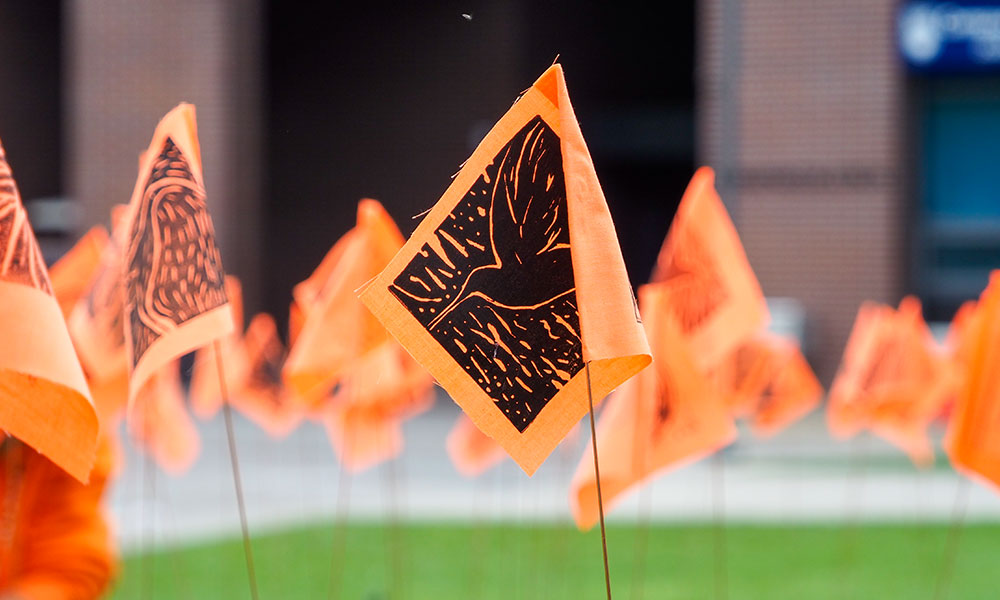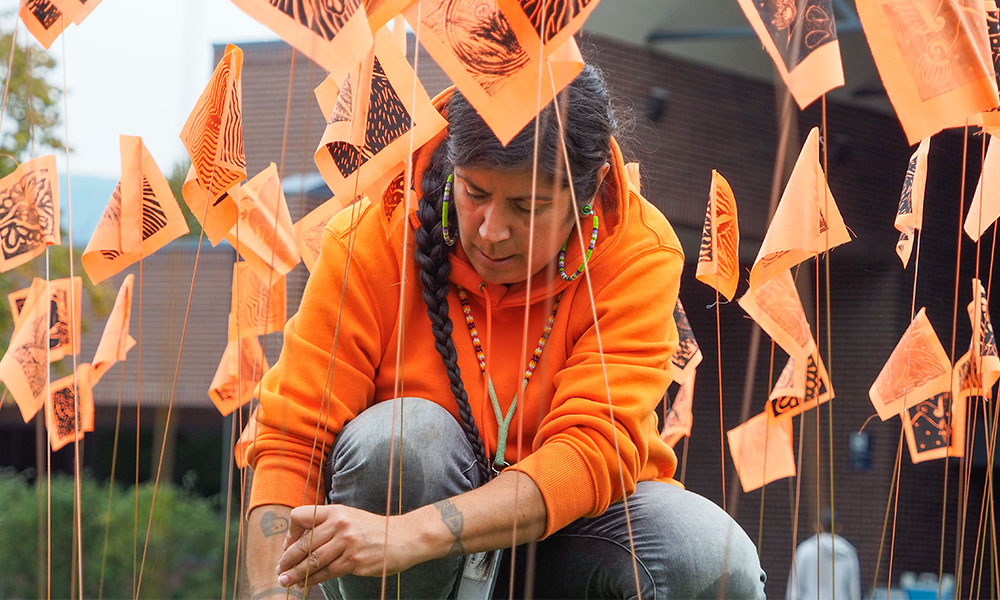
EVERY SEPTEMBER 30, UBC OKANAGAN’S COURTYARD transforms into a sea of brightly coloured orange flags. Fluttering in the autumn wind, each flag is imprinted with an intricate and unique depiction of a hummingbird; gentle yet fierce creatures, the birds are known as defenders of their territory and are symbols of healing, help and renewal.
The tableau is a poignant meld of art and advocacy, standing as a powerful symbol of healing from the residential school system, and to honour both individuals who attended the schools and those who didn’t make it home.
For visual artist and Assistant Professor Tania Willard, the annual installation is her way of bringing diverse groups together to engage in dialogue about the devastating impacts of the residential school system and how to start enacting just futures for coming generations.
“Stories of mass graves at residential schools were known in my community; it wasn’t talked about in settler communities, but it was talked about in a hushed, traumatic way in Indigenous communities,” explains Willard, who is of Secwépemc and settler ancestry and grew up between the Secwépemc and Syilx territories in Armstrong, BC.
“It was a difficult but known reality for my people.”

In 2013, the first Orange Shirt Day events took place in Williams Lake, BC, to commemorate the residential school experience, to witness and honour the healing journey of survivors and their families, and to commit to ongoing reconciliation.
The colour orange symbolizes the stripping away of culture, freedom and self-esteem experienced by Indigenous children over generations, while September 30 was chosen because it was the time of year when children were taken from their homes to residential schools.
In 2021, the federal government established September 30 as the National Day for Truth and Reconciliation, a day of public commemoration originally recommended by the Truth and Reconciliation Commission of Canada in its 2015 Calls to Action.
Willard’s research in UBC Okanagan’s Faculty of Creative and Critical Studies focuses on Indigenous resilience, strength and resurgence, and its intersection with land-based art practices. Themes of justice and equality have always interested Willard, so when the university sought ways to strengthen the conversations around reconciliation, she knew she could contribute.
“These unmarked graves are more than just numbers; they’re people’s children, their aunties, their uncles, their siblings, their cousins. I feel like it’s my commitment and responsibility as someone who lives and visits the Secwépemc and Syilx territories to raise these issues surrounding reconciliation and the search for justice.”
A song her sister, Tara Willard, shared about hummingbirds first spurred Willard’s creativity and imagination; she began considering the strength and resiliency of the hummingbird despite its small size. At the same time, Willard noticed the birds earnestly returning to the region, especially where she lives on Neskonlith Indian Reserve, near Chase, BC.
An idea for the installation soon began taking shape. Willard chose to print depictions of hummingbirds—ultimately created by workshop attendees—on flags, something she previously used in her art practice.
“Flags are used in infrastructure projects to show caution or something buried below; they’re also used archaeologically to mark grave sites. Many years before the remains of 215 children, or little spirits, were discovered at the Kamloops Indian Residential School, I used flags to connect ideas of survey and land rights.

“For me, it was important to bring together how I saw hummingbirds on the land, the emerging stories about unmarked graves and the strength and beauty present in such a small creature. In printmaking, we also make multiples of our work, so using that medium reflected all the spirits who have passed on.”
Crucial to the installation is the involvement of dozens of workshop attendees leading up to Orange Shirt Day, who each design and print their own flags. Willard hopes that bringing people together year after year for the workshop and flag installation will create more sustained conversation, support and action.
“Through art, these people are generating a collective experience that can help them find a level of responsibility in moving forward to seek justice and reconciliation.”
She adds: “I truly believe creative expression can help stir some of these transformative conversations about truth, healing and renewal.”
To learn more about Orange Shirt Day and to access support resources, please visit UBC Okanagan’s Orange Shirt Day page.






